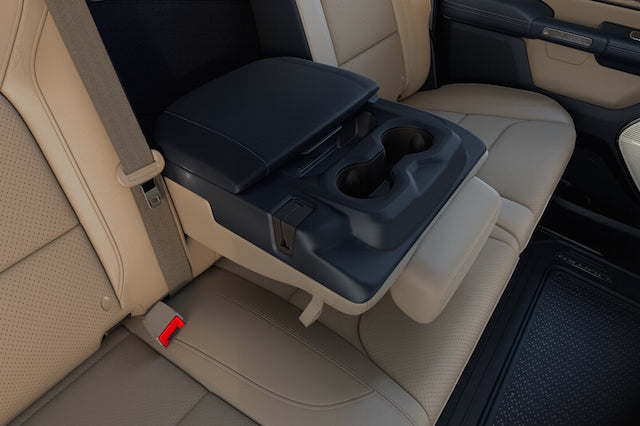Portable Sleeping Mats A Comprehensive Guide to Comfort On the Go
Whether you're an avid camper, backpacker, or just someone who enjoys spending time outdoors, a comfortable sleeping mat is essential for a good night's sleep. With so many different types of sleeping mats on the market, it can be difficult to know which one is right for you. This comprehensive guide will help you choose the ideal portable sleeping mat for your needs, so you can enjoy a restful night's sleep even when you're away from home.
Choosing the Right Portable Sleeping Mat: A Comprehensive Guide
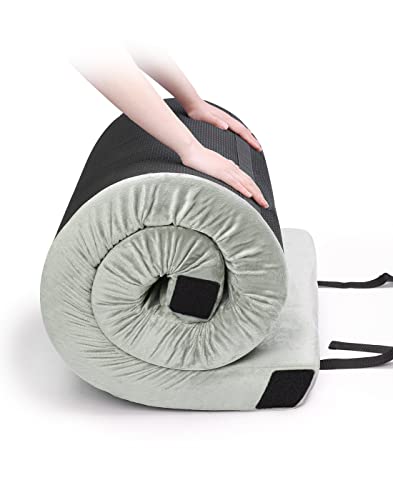
When it comes to selecting a portable sleeping mat, there are several factors to consider. From the type of mat to the size and weight, choosing the right one can make a significant difference in your overall comfort while sleeping outdoors. Here are some essential features to consider when shopping for a portable sleeping mat:
Essential Features to Consider for Portable Sleeping Mats
- Insulation: Make sure the sleeping mat provides adequate insulation from the cold ground, especially if you'll be camping in cooler temperatures.
- Thickness: The thickness of the mat will determine how much cushioning and support it provides. Thicker mats are generally more comfortable but can also be bulkier.
- Packability: Consider how easy it is to pack and carry the sleeping mat, especially if you'll be hiking long distances with it in your backpack.
- R-Value: The R-value of a sleeping mat indicates its thermal resistance. A higher R-value means better insulation, which is important for cold weather camping.
- Inflation Method: Decide whether you prefer a mat that requires manual inflation, self-inflates, or uses an external pump.
To help you further understand the different types of portable sleeping mats available, here is a breakdown of the most common options:
| Type of Sleeping Mat | Description | Pros | Cons |
|---|---|---|---|
| Foam Mats | Made from a thick layer of foam | Affordable, provide insulation | Bulky and not very packable |
| Inflatable Mats | Lightweight fabric filled with air | Packable, comfortable | More expensive |
| Self-Inflating Mats | Hybrid of foam and air layers | Packable, decent comfort | Not as comfortable as inflatable mats |
| Air Pads | Thin, durable fabric filled with air | Very packable, lightweight | Less comfortable than inflatable mats |
Inflatable vs. Self-Inflating: Pros and Cons of Portable Sleeping Mats
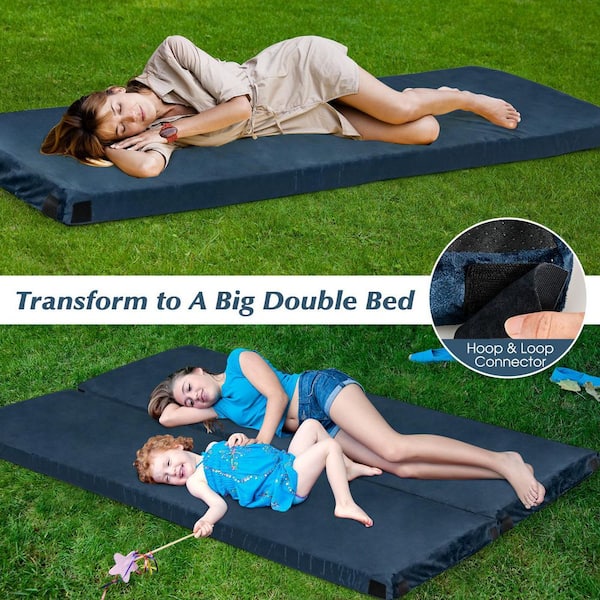
When it comes to choosing between inflatable and self-inflating sleeping mats, there are distinct pros and cons to consider. Understanding the differences can help you make an informed decision based on your specific needs and preferences.
Pros of Inflatable Mats
- Comfort: Inflatable mats tend to offer superior comfort and support compared to other types of sleeping mats.
- Packability: They are highly packable and take up minimal space in your backpack, making them ideal for backpackers.
- Customizable Firmness: You can adjust the firmness of the mat by adding or releasing air, allowing you to customize your sleeping surface.
Cons of Inflatable Mats
- Puncture Risk: Inflatable mats are more susceptible to punctures from sharp objects, requiring extra care when setting them up.
- Setup Time: They may take longer to inflate and deflate compared to self-inflating mats, which can be less convenient.
- Price: Inflatable mats are typically more expensive than foam or self-inflating mats, which can be a drawback for budget-conscious campers.
Pros of Self-Inflating Mats
- Convenience: Self-inflating mats automatically expand when the valve is opened, saving you time and effort during setup.
- Insulation: The foam layer in self-inflating mats provides additional insulation from the cold ground, improving overall warmth.
- Durable: These mats are known for their durability and resistance to punctures, offering peace of mind during outdoor adventures.
Cons of Self-Inflating Mats
- Bulkiness: Self-inflating mats can be bulkier than inflatable mats due to the foam layer, making them less compact for packing.
- Weight: They tend to be heavier than inflatable mats, which can be a concern for ultralight backpackers looking to minimize weight.
- Less Customization: Unlike inflatable mats, self-inflating mats have limited firmness adjustments, which may not suit all sleepers' preferences.
Tips for Selecting Portable Sleeping Mats for Different Activities

The type of portable sleeping mat you choose should align with the specific activities you plan to engage in. Whether you're backpacking through rugged terrain or car camping at a designated site, here are some tips for selecting the right sleeping mat based on your intended outdoor pursuits:
Backpacking
- Weight Matters: Opt for a lightweight and compact sleeping mat to minimize the burden on your back during long hikes.
- Packability: Look for a mat that can easily roll up or fold into a small size to fit inside your backpack without taking up too much space.
- Durability: Choose a mat made from durable materials that can withstand rough terrain and potential abrasions.
Car Camping
- Focus on Comfort: Since weight and packability are less of a concern for car camping, prioritize comfort and support when selecting a sleeping mat.
- Size Consideration: Take into account the dimensions of your tent or sleeping area to ensure the mat fits comfortably without overcrowding the space.
- Additional Features: Consider features like built-in pillows or side rails for added convenience and luxury during car camping trips.
Winter Camping
- High R-Value: Opt for a sleeping mat with a high R-value to provide maximum insulation against the cold ground and prevent heat loss.
- Thermal Reflective Layers: Look for mats with thermal reflective layers to bounce body heat back to you, keeping you warm in frigid temperatures.
- Extra Insulation: Consider pairing your sleeping mat with a closed-cell foam pad for additional insulation in extreme winter conditions.
Durability and Maintenance of Portable Sleeping Mats

Ensuring the longevity of your portable sleeping mat involves proper maintenance and care. By following these tips, you can extend the lifespan of your mat and continue enjoying comfortable nights under the stars:
- Regular Cleaning: Wipe down the sleeping mat with a damp cloth after each use to remove dirt, sweat, and debris that can cause wear and tear over time.
- Storage: Store your sleeping mat flat or loosely rolled in a cool, dry place to prevent creases or damage from being folded for an extended period.
- Repair Kit: Carry a repair kit with patches and adhesive specifically designed for your mat to quickly fix any punctures or leaks during outdoor excursions.
- Avoid Sharp Objects: Keep your sleeping mat away from sharp objects, rocks, or rough surfaces that could potentially puncture or damage the material.
- Proper Inflation: Follow the manufacturer's guidelines for inflating your mat to the recommended firmness level, preventing overinflation that can strain the seams.
Compact and Lightweight: Choosing Portable Sleeping Mats for Backpackers

For backpackers who prioritize traveling light and efficiently, selecting a compact and lightweight sleeping mat is crucial. Here are some key considerations when choosing a portable sleeping mat for backpacking adventures:
- Ultralight Materials: Opt for sleeping mats made from ultralight materials like ripstop nylon or polyester to reduce overall pack weight without sacrificing durability.
- Minimalist Design: Choose a mat with a minimalist design that eliminates unnecessary bulk and features, focusing on essential comfort and insulation.
- Air Construction: Select an inflatable or air pad sleeping mat with a streamlined construction that minimizes weight while providing adequate cushioning for a good night's sleep.
To further assist you in finding the perfect portable sleeping mat for backpacking, here are three top-rated options renowned for their compactness and lightweight design:
Top 3 Compact and Lightweight Sleeping Mats for Backpackers
-
Therm-a-Rest NeoAir XLite
- Weight: 12 ounces
- Packed Size: 9 x 4 inches
- R-Value: 4.2
- Material: Nylon
- Features: Reflective ThermaCapture technology for enhanced warmth
-
Sea to Summit Ultralight Mat
- Weight: 13.9 ounces
- Packed Size: 4 x 9 inches
- R-Value: 0.7
- Material: Nylon with TPU coating
- Features: Multi-function valve for easy inflation and deflation
-
Big Agnes Q-Core SLX
- Weight: 16 ounces
- Packed Size: 4 x 8 inches
- R-Value: 3.2
- Material: Ripstop nylon
- Features: Quilted pattern for added stability and comfort
Comfort and Support: A Key Factor in Selecting Portable Sleeping Mats
Achieving a good night's sleep in the great outdoors starts with selecting a portable sleeping mat that offers both comfort and support. Here are three essential factors to consider when prioritizing comfort in your sleeping mat choice:
- Thickness and Padding: Opt for a sleeping mat with ample thickness and padding to cushion pressure points and provide a plush sleeping surface.
- Body Contouring: Look for a mat that contours to your body shape, distributing weight evenly and reducing discomfort from uneven surfaces.
- Stability: Choose a sleeping mat with stable construction that prevents excessive movement or shifting during the night, ensuring a restful sleep experience.
By prioritizing comfort and support in your selection process, you can create a cozy and inviting sleep environment no matter where your outdoor adventures take you.
Temperature Regulation: Finding Portable Sleeping Mats for All Climates
Temperature regulation is a critical consideration when choosing a portable sleeping mat, especially for outdoor enthusiasts who venture into diverse climates. Here are three key factors to keep in mind when selecting a sleeping mat based on temperature requirements:
- R-Value Rating: Choose a sleeping mat with an appropriate R-value rating that matches the temperature range of your camping destinations.
- Seasonality: Consider the seasonality of your camping trips and select a sleeping mat designed for summer, three-season, or winter use accordingly.
- Breathability: Opt for a sleeping mat with breathable materials that wick away moisture and promote airflow for increased comfort in warmer conditions.
For campers seeking versatility across various climates, investing in multiple sleeping mats with varying insulation levels can ensure optimal comfort and warmth no matter the outdoor setting.
Accessories and Attachments for Portable Sleeping Mats
Enhance the functionality and comfort of your portable sleeping mat with a range of accessories and attachments designed to elevate your outdoor sleeping experience. Here are three popular accessories to consider pairing with your sleeping mat:
- Inflatable Pillow: Add a lightweight inflatable pillow to your sleep system for extra head and neck support without occupying valuable pack space.
- Sleeping Pad Cover: Invest in a soft and washable sleeping pad cover to protect your mat from dirt, sweat, and abrasions while providing a cozy surface for resting.
- Compression Straps: Secure your rolled-up sleeping mat with compression straps to streamline packing and prevent it from unrolling during transport.
By incorporating these accessories into your camping gear arsenal, you can maximize the comfort and convenience of your portable sleeping mat setup for a rejuvenating night's sleep in nature.
Reviewing the Latest Innovations in Portable Sleeping Mat Technology
As advancements in outdoor gear technology continue to evolve, so do the features and innovations in portable sleeping mats. Here are three cutting-edge developments shaping the future of portable sleeping mat technology:
- Integrated Pump Systems: Some inflatable sleeping mats now come equipped with integrated pump systems that eliminate the need for manual inflation, offering quick and effortless setup in seconds.
- Insulated Chambers: Sleeping mats with insulated chambers strategically placed along the surface provide targeted warmth and enhanced thermal efficiency for cold weather camping.
- Modular Design: Modular sleeping mats allow campers to customize their sleep setup by connecting multiple mats together for expanded coverage or disconnecting them for individual use.
By staying informed about the latest advancements in portable sleeping mat technology, outdoor enthusiasts can make informed decisions when upgrading their gear for enhanced comfort and performance in the wilderness.
Conclusion
In conclusion, selecting the right portable sleeping mat is essential for ensuring a comfortable and restorative night's sleep during outdoor adventures. By considering factors such as insulation, packability, comfort, and temperature regulation, you can choose a sleeping mat that meets your specific needs and preferences.
Whether you opt for an inflatable mat for superior comfort, a self-inflating mat for convenience, or an air pad for packability, there is a wide range of options available to cater to different outdoor activities and climates. By prioritizing durability, maintenance, and additional accessories, you can enhance the longevity and functionality of your sleeping mat for years to come.
Remember to evaluate essential features, compare pros and cons, and explore innovative technologies to make an informed decision when selecting a portable sleeping mat that aligns with your camping style and preferences. With the right sleeping mat by your side, you can embark on outdoor escapades with confidence, knowing that a peaceful night's sleep awaits beneath the stars.
Choosing the Right Portable Sleeping Mat: A Comprehensive Guide
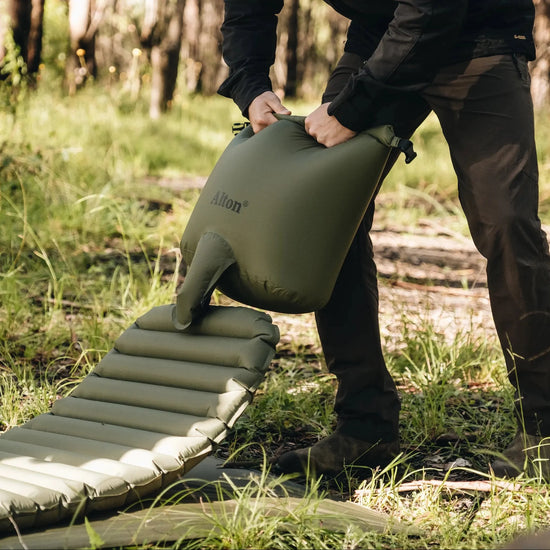
When it comes to outdoor adventures, a good night's sleep is essential for recharging and rejuvenating. Selecting the right portable sleeping mat can make all the difference in ensuring comfort and restfulness during your camping trips. From backpacking excursions to car camping weekends, there are various factors to consider when choosing a portable sleeping mat that suits your needs and preferences.
Essential Features to Consider for Portable Sleeping Mats
Before making a decision on which portable sleeping mat to invest in, it's important to understand the essential features that differentiate various models. Here are three key factors to consider:
- Size and Weight: Consider the dimensions and weight of the sleeping mat, especially if you'll be carrying it for long distances while backpacking. Opt for a compact and lightweight design that fits easily into your pack.
- Insulation and R-Value: Insulation is crucial for staying warm during cold nights. Check the R-Value of the sleeping mat, which indicates its thermal resistance. Choose a mat with a higher R-Value for colder conditions.
- Inflation Type: Decide whether you prefer an inflatable mat that requires manual or pump inflation, or a self-inflating mat that expands on its own. Each type has its pros and cons in terms of convenience and comfort.
By considering these essential features, you can narrow down your options and select a portable sleeping mat that aligns with your camping style and requirements.
Inflatable vs. Self-Inflating: Pros and Cons of Portable Sleeping Mats

When it comes to portable sleeping mats, two popular options are inflatable mats and self-inflating mats. Understanding the pros and cons of each type can help you make an informed decision:
| Features | Inflatable Mats | Self-Inflating Mats |
|---|---|---|
| Comfort | Offers customizable firmness | Provides consistent cushioning |
| Packability | Compact when deflated | Bulkier due to internal structure |
| Insulation | Limited insulation without additional layers | Enhanced insulation for colder nights |
| Setup | Requires manual or pump inflation | Self-expands with minimal effort |
Ultimately, the choice between inflatable and self-inflating mats depends on your priorities regarding comfort, insulation, and convenience. Consider your camping habits and the environmental conditions you're likely to encounter to determine which type of sleeping mat best suits your needs.
Tips for Selecting Portable Sleeping Mats for Different Activities
Not all portable sleeping mats are created equal, and the ideal mat for one activity may not be suitable for another. Here are some tips for selecting sleeping mats based on different types of outdoor activities:
- Backpacking: Prioritize lightweight and compact sleeping mats for backpacking trips to minimize weight in your pack. Look for models with a high warmth-to-weight ratio for optimal insulation.
- Car Camping: Comfort is key for car camping, so opt for thicker and more plush sleeping mats that provide ample cushioning. Size and weight are less of a concern when you're not carrying the mat over long distances.
- Mountaineering: In cold and high-altitude environments, insulation is critical. Choose a sleeping mat with a high R-Value and excellent thermal performance to stay warm in extreme conditions.
By tailoring your choice of sleeping mat to the specific demands of your outdoor activities, you can enhance your overall camping experience and enjoy a better night's sleep under any circumstances.
Durability and Maintenance of Portable Sleeping Mats
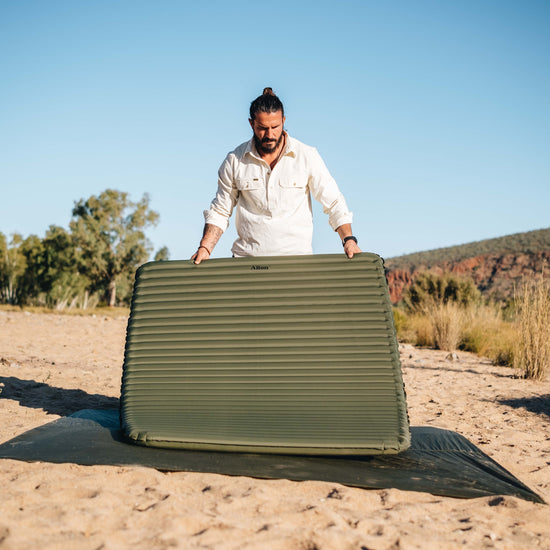
Investing in a durable and easy-to-maintain sleeping mat can prolong its lifespan and ensure reliable performance on numerous camping trips. Here are three tips for maintaining the durability of your portable sleeping mat:
- Cleaning and Storage: Regularly clean your sleeping mat according to the manufacturer's instructions to prevent mold, mildew, and odors. Store it properly in a dry and cool place when not in use.
- Repair Kit: Carry a repair kit with patches and adhesive to quickly fix any punctures or leaks that may occur during outdoor excursions. Prompt repairs can prevent further damage to the mat.
- Avoid Rough Surfaces: Place a ground cloth or tarp beneath your sleeping mat to protect it from sharp objects or rough terrain that could cause abrasions or tears. Avoid setting up camp on rocky or uneven surfaces whenever possible.
By taking proactive measures to care for your portable sleeping mat, you can maximize its longevity and reliability, ensuring that it continues to provide comfortable nights of sleep under the stars.
Compact and Lightweight: Choosing Portable Sleeping Mats for Backpackers

For backpackers who prioritize minimizing weight and maximizing pack space, choosing a compact and lightweight sleeping mat is crucial. Here are two top-rated options known for their portability and performance:
Therm-a-Rest NeoAir XLite
- Weight: 13.9 ounces
- Packed Size: 4 x 9 inches
- R-Value: 0.7
- Material: Nylon with TPU coating
- Features: Multi-function valve for easy inflation and deflation
Big Agnes Q-Core SLX
- Weight: 16 ounces
- Packed Size: 4 x 8 inches
- R-Value: 3.2
- Material: Ripstop nylon
- Features: Quilted pattern for added stability and comfort
By opting for lightweight sleeping mats like the Therm-a-Rest NeoAir XLite and the Big Agnes Q-Core SLX, backpackers can enjoy a comfortable and well-supported night's sleep without compromising on portability during their outdoor adventures.
Comfort and Support: A Key Factor in Selecting Portable Sleeping Mats
Achieving a good night's sleep in the great outdoors starts with selecting a portable sleeping mat that offers both comfort and support. Here are three essential factors to consider when prioritizing comfort in your sleeping mat choice:
- Thickness and Padding: Opt for a sleeping mat with ample thickness and padding to cushion pressure points and provide a plush sleeping surface.
- Body Contouring: Look for a mat that contours to your body shape, distributing weight evenly and reducing discomfort from uneven surfaces.
- Stability: Choose a sleeping mat with stable construction that prevents excessive movement or shifting during the night, ensuring a restful sleep experience.
By prioritizing comfort and support in your selection process, you can create a cozy and inviting sleep environment no matter where your outdoor adventures take you.
Temperature Regulation: Finding Portable Sleeping Mats for All Climates
Temperature regulation is a critical consideration when choosing a portable sleeping mat, especially for outdoor enthusiasts who venture into diverse climates. Here are three key factors to keep in mind when selecting a sleeping mat based on temperature requirements:
- R-Value Rating: Choose a sleeping mat with an appropriate R-value rating that matches the temperature range of your camping destinations.
- Seasonality: Consider the seasonality of your camping trips and select a sleeping mat designed for summer, three-season, or winter use accordingly.
- Breathability: Opt for a sleeping mat with breathable materials that wick away moisture and promote airflow for increased comfort in warmer conditions.
For campers seeking versatility across various climates, investing in multiple sleeping mats with varying insulation levels can ensure optimal comfort and warmth no matter the outdoor setting.
Accessories and Attachments for Portable Sleeping Mats
Enhance the functionality and comfort of your portable sleeping mat with a range of accessories and attachments designed to elevate your outdoor sleeping experience. Here are three popular accessories to consider pairing with your sleeping mat:
- Inflatable Pillow: Add a lightweight inflatable pillow to your sleep system for extra head and neck support without occupying valuable pack space.
- Sleeping Pad Cover: Invest in a soft and washable sleeping pad cover to protect your mat from dirt, sweat, and abrasions while providing a cozy surface for resting.
- Compression Straps: Secure your rolled-up sleeping mat with compression straps to streamline packing and prevent it from unrolling during transport.
By incorporating these accessories into your camping gear arsenal, you can maximize the comfort and convenience of your portable sleeping mat setup for a rejuvenating night's sleep in nature.
Reviewing the Latest Innovations in Portable Sleeping Mat Technology

As advancements in outdoor gear technology continue to evolve, so do the features and innovations in portable sleeping mats. Here are three cutting-edge developments shaping the future of portable sleeping mat technology:
- Integrated Pump Systems: Some inflatable sleeping mats now come equipped with integrated pump systems that eliminate the need for manual inflation, offering quick and effortless setup in seconds.
- Insulated Chambers: Sleeping mats with insulated chambers strategically placed along the surface provide targeted warmth and enhanced thermal efficiency for cold weather camping.
- Modular Design: Modular sleeping mats allow campers to customize their sleep setup by connecting multiple mats together for expanded coverage or disconnecting them for individual use.
By staying informed about the latest advancements in portable sleeping mat technology, outdoor enthusiasts can make informed decisions when upgrading their gear for enhanced comfort and performance in the wilderness.
Conclusion
In conclusion, selecting the right portable sleeping mat is essential for ensuring a comfortable and restorative night's sleep during outdoor adventures. By considering factors such as insulation, packability, comfort, and temperature regulation, you can choose a sleeping mat that meets your specific needs and preferences.
Whether you opt for an inflatable mat for superior comfort, a self-inflating mat for convenience, or an air pad for packability, there is a wide range of options available to cater to different outdoor activities and climates. By prioritizing durability, maintenance, and additional accessories, you can enhance the longevity and functionality of your sleeping mat for years to come.
Remember to evaluate essential features, compare pros and cons, and explore innovative technologies to make an informed decision when selecting a portable sleeping mat that aligns with your camping style and preferences. With the right sleeping mat by your side, you can embark on outdoor escapades with confidence, knowing that a peaceful night's sleep awaits beneath the stars.

